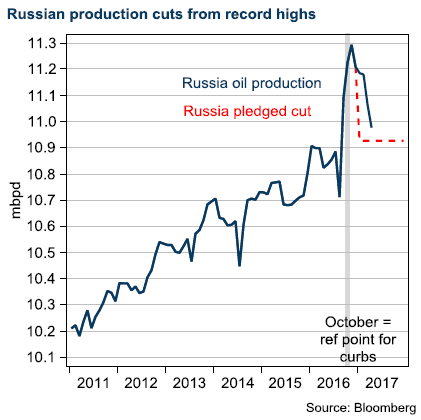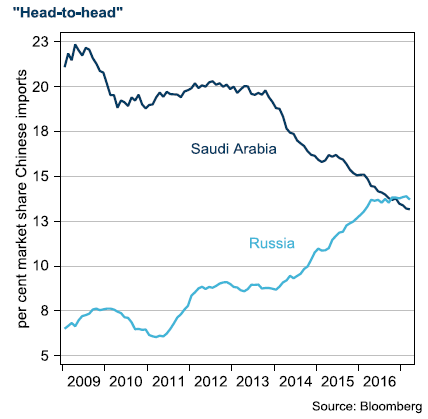Analys
The last hurrah from Vienna

![]() We see a close to 100% probability of an extension of oil production cuts from OPEC at the upcoming OPEC meeting in Vienna on May 25. For H2 2017, we see compliance with proposed cuts as a much more difficult issue than the deal itself. We think there is a 95% probability that Russia will sign on for a new six-month production cut period, but we see only a 30% probability that Russia will keep compliance for that period. Oil cuts during H2 2017 will come at a high cost due to seasonally higher production. We believe the next big price turn will come from non-compliance from Russia in particular but also other OPEC countries, as growing US production shows evidence of the futility of subsidising growth there by keeping production off stream. Saudi Arabia seems assured that production cuts at any price are the right way to go; it seems to us that the longer OPEC tries to keep production down, the more such measures backfire.
We see a close to 100% probability of an extension of oil production cuts from OPEC at the upcoming OPEC meeting in Vienna on May 25. For H2 2017, we see compliance with proposed cuts as a much more difficult issue than the deal itself. We think there is a 95% probability that Russia will sign on for a new six-month production cut period, but we see only a 30% probability that Russia will keep compliance for that period. Oil cuts during H2 2017 will come at a high cost due to seasonally higher production. We believe the next big price turn will come from non-compliance from Russia in particular but also other OPEC countries, as growing US production shows evidence of the futility of subsidising growth there by keeping production off stream. Saudi Arabia seems assured that production cuts at any price are the right way to go; it seems to us that the longer OPEC tries to keep production down, the more such measures backfire.
Core OPEC members give a good lead
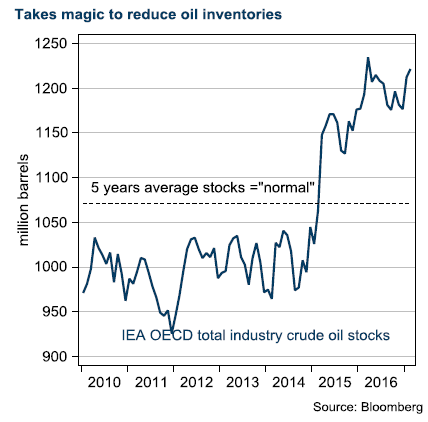 The OPEC and several other key producers including Russia have agreed to cut production by 1.8 million bbl/d for H1 2017 to reduce global glut, formally defined as retreating global stocks to normal levels, i.e. the five-year average. It is increasingly clear that the target will not be reached after the first six months of this year. Saudi Arabian oil minister Al-Falih opened up initially for an extension for H2 2017, and last week for nine months, including Q1 2018. Other core OPEC members have gradually confirmed the extension as well. We assume a Brent crude price of USD 50 fully reflects a six-month extension of OPEC production cuts.
The OPEC and several other key producers including Russia have agreed to cut production by 1.8 million bbl/d for H1 2017 to reduce global glut, formally defined as retreating global stocks to normal levels, i.e. the five-year average. It is increasingly clear that the target will not be reached after the first six months of this year. Saudi Arabian oil minister Al-Falih opened up initially for an extension for H2 2017, and last week for nine months, including Q1 2018. Other core OPEC members have gradually confirmed the extension as well. We assume a Brent crude price of USD 50 fully reflects a six-month extension of OPEC production cuts.
Saudi Arabia supports extension
It has become obvious that Deputy Crown Prince Mohammed bin Salman, who has emerged as Saudi Arabia’s leading economic force, was the architect behind the Saudis’ policy U-turn in Doha, leading up to the cut at the official meeting in Vienna in November 2016. In our view, this was confirmed by the shuffle of the Kingdom’s oil minister, replacing Ali al-Naimi after two decades. If this were a game of chess, we would view this as a rokade.
Prince Mohammed has designated divesting Armaco at the top of his agenda, and that forms the basis of the Saudis’ policy and willingness to cut production in compensation for a short-term higher oil price.
Costly mistake
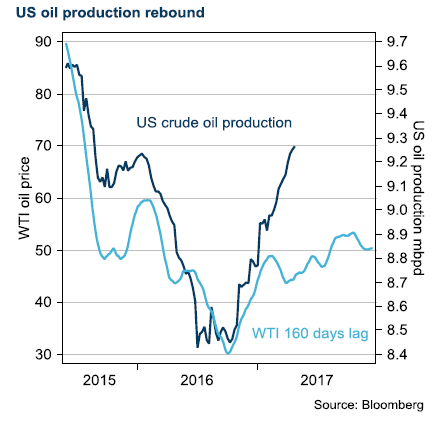 The savvy players recognise the danger of taking real action in cutting production. History is repeating itself. Higher prices have reversed the US production drop, extending the time it takes for the market to balance, and pushing the volume share away from OPEC and toward two non-cut participants, the US and lately also Libya.
The savvy players recognise the danger of taking real action in cutting production. History is repeating itself. Higher prices have reversed the US production drop, extending the time it takes for the market to balance, and pushing the volume share away from OPEC and toward two non-cut participants, the US and lately also Libya.
We strongly argue it was too early for OPEC to take action. The rebalancing process had another year, perhaps two, before running its course. If OPEC had waited, a number of bankruptcies in the US energy sector would have played out, and some banks would have lost their faith in energy lending for a long time. Instead, US shale oil is growing at the same rate as it did before the 2014 oil slump and production is now higher than in 2014, which was about the time that OPEC initiated its strategy aimed at knocking off higher costs by flooding the market. Costs are dynamic, however, and the low-price era has pushed breakeven levels lower and provided a solid platform for future growth.
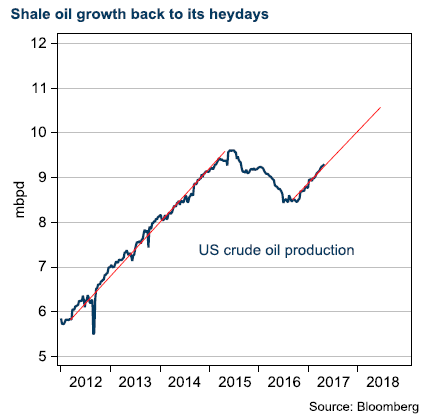 Russia: biggest loser in extension deal
Russia: biggest loser in extension deal
We base our strong opinion of a low 30% chance of an implemented cut during the second half on Russia’s seasonal oil production pattern. Russia has shown its usual low interest in active cuts, and takes its cut from a very high October 2016 production as a reference point for the curbs. Russia has cut about 250,000 bbl/d from its pledge of a 300,000 bbl/d cut, but production is still 1.6% higher than in 2016 and export are 2.14% higher than in March 2016. The first quarter is seasonally weak in Russian crude production, while the second half is stronger, and cuts in the seasonal peak require a strong commitment. We doubt that Russia will turn down additional market share for the sake of Saudi Arabia’s Aramco divestment.
Russia has another reason to be careful in long-term cooperation with the Saudis. Russia has been successful in grabbing market share in China, the only oil consumer growing at any significant pace. This is not the right time to give up footprint anywhere, as competition will increase in all markets ahead.
“Everything is fine”
With little chance of action from Vienna on May 25, we think eroding compliance will set the tone after the May meeting. The oil price will likely hover at around USD 40/bbl when the agreement on production cuts vanishes, and an extension of production cuts will not come into question at the second OPEC meeting this year in November-December.
Research disclaimer
Risk warning
All investments involve risks and investors are encouraged to make their own decision as to the appropriateness of an investment in any securities referred to in this report, based on their specific investment objectives, financial status and risk tolerance. The historical return of a financial instrument is not a guarantee of future return. The value of financial instruments can rise or fall, and it is not certain that you will get back all the capital you have invested.
Research disclaimers
Handelsbanken Capital Markets, a division of Svenska Handelsbanken AB (publ) (collectively referred to herein as ‘SHB’), is responsible for the preparation of research reports. SHB is regulated in Sweden by the Swedish Financial Supervisory Authority, in Norway by the Financial Supervisory Authority of Norway, in Finland by the Financial Supervisory Authority and in Denmark by the Danish Financial Supervisory Authority. All research reports are prepared from trade and statistical services and other information that SHB considers to be reliable. SHB has not independently verified such information and does not represent that such information is true, accurate or complete. Accordingly, to the extent permitted by law, neither SHB, nor any of its directors, officers or employees, nor any other person, accept any liability whatsoever for any loss, however it arises, from any use of such research reports or its contents or otherwise arising in connection therewith.
In no event will SHB or any of its affiliates, their officers, directors or employees be liable to any person for any direct, indirect, special or consequential damages arising out of any use of the information contained in the research reports, including without limitation any lost profits even if SHB is expressly advised of the possibility or likelihood of such damages.
The views contained in SHB research reports are the opinions of employees of SHB and its affiliates and accurately reflect the personal views of the respective analysts at this date and are subject to change. There can be no assurance that future events will be consistent with any such opinions. Each analyst identified in this research report also certifies that the opinions expressed herein and attributed to such analyst accurately reflect his or her individual views about the companies or securities discussed in the research report.
Research reports are prepared by SHB for information purposes only. The information in the research reports does not constitute a personal recommendation or personalised investment advice and such reports or opinions should not be the basis for making investment or strategic decisions. This document does not constitute or form part of any offer for sale or subscription of or solicitation of any offer to buy or subscribe for any securities nor shall it or any part of it form the basis of or be relied on in connection with any contract or commitment whatsoever. Past performance may not be repeated and should not be seen as an indication of future performance. The value of investments and the income from them may go down as well as up and investors may forfeit all principal originally invested. Investors are not guaranteed to make profits on investments and may lose money. Exchange rates may cause the value of overseas investments and the income arising from them to rise or fall. This research product will be updated on a regular basis.
No part of SHB research reports may be reproduced or distributed to any other person without the prior written consent of SHB. The distribution of this document in certain jurisdictions may be restricted by law and persons into whose possession this document comes should inform themselves about, and observe, any such restrictions.
The report does not cover any legal or tax-related aspects pertaining to any of the issuer’s planned or existing debt issuances.
Analys
Tightening fundamentals – bullish inventories from DOE

The latest weekly report from the US DOE showed a substantial drawdown across key petroleum categories, adding more upside potential to the fundamental picture.

Commercial crude inventories (excl. SPR) fell by 5.8 million barrels, bringing total inventories down to 415.1 million barrels. Now sitting 11% below the five-year seasonal norm and placed in the lowest 2015-2022 range (see picture below).
Product inventories also tightened further last week. Gasoline inventories declined by 2.1 million barrels, with reductions seen in both finished gasoline and blending components. Current gasoline levels are about 3% below the five-year average for this time of year.
Among products, the most notable move came in diesel, where inventories dropped by almost 4.1 million barrels, deepening the deficit to around 20% below seasonal norms – continuing to underscore the persistent supply tightness in diesel markets.
The only area of inventory growth was in propane/propylene, which posted a significant 5.1-million-barrel build and now stands 9% above the five-year average.
Total commercial petroleum inventories (crude plus refined products) declined by 4.2 million barrels on the week, reinforcing the overall tightening of US crude and products.


Analys
Bombs to ”ceasefire” in hours – Brent below $70

A classic case of “buy the rumor, sell the news” played out in oil markets, as Brent crude has dropped sharply – down nearly USD 10 per barrel since yesterday evening – following Iran’s retaliatory strike on a U.S. air base in Qatar. The immediate reaction was: “That was it?” The strike followed a carefully calibrated, non-escalatory playbook, avoiding direct threats to energy infrastructure or disruption of shipping through the Strait of Hormuz – thus calming worst-case fears.

After Monday morning’s sharp spike to USD 81.4 per barrel, triggered by the U.S. bombing of Iranian nuclear facilities, oil prices drifted sideways in anticipation of a potential Iranian response. That response came with advance warning and caused limited physical damage. Early this morning, both the U.S. President and Iranian state media announced a ceasefire, effectively placing a lid on the immediate conflict risk – at least for now.
As a result, Brent crude has now fallen by a total of USD 12 from Monday’s peak, currently trading around USD 69 per barrel.
Looking beyond geopolitics, the market will now shift its focus to the upcoming OPEC+ meeting in early July. Saudi Arabia’s decision to increase output earlier this year – despite falling prices – has drawn renewed attention considering recent developments. Some suggest this was a response to U.S. pressure to offset potential Iranian supply losses.
However, consensus is that the move was driven more by internal OPEC+ dynamics. After years of curbing production to support prices, Riyadh had grown frustrated with quota-busting by several members (notably Kazakhstan). With Saudi Arabia cutting up to 2 million barrels per day – roughly 2% of global supply – returns were diminishing, and the risk of losing market share was rising. The production increase is widely seen as an effort to reassert leadership and restore discipline within the group.
That said, the FT recently stated that, the Saudis remain wary of past missteps. In 2018, Riyadh ramped up output at Trump’s request ahead of Iran sanctions, only to see prices collapse when the U.S. granted broad waivers – triggering oversupply. Officials have reportedly made it clear they don’t intend to repeat that mistake.
The recent visit by President Trump to Saudi Arabia, which included agreements on AI, defense, and nuclear cooperation, suggests a broader strategic alignment. This has fueled speculation about a quiet “pump-for-politics” deal behind recent production moves.
Looking ahead, oil prices have now retraced the entire rally sparked by the June 13 Israel–Iran escalation. This retreat provides more political and policy space for both the U.S. and Saudi Arabia. Specifically, it makes it easier for Riyadh to scale back its three recent production hikes of 411,000 barrels each, potentially returning to more moderate increases of 137,000 barrels for August and September.
In short: with no major loss of Iranian supply to the market, OPEC+ – led by Saudi Arabia – no longer needs to compensate for a disruption that hasn’t materialized, especially not to please the U.S. at the cost of its own market strategy. As the Saudis themselves have signaled, they are unlikely to repeat previous mistakes.
Conclusion: With Brent now in the high USD 60s, buying oil looks fundamentally justified. The geopolitical premium has deflated, but tensions between Israel and Iran remain unresolved – and the risk of missteps and renewed escalation still lingers. In fact, even this morning, reports have emerged of renewed missile fire despite the declared “truce.” The path forward may be calmer – but it is far from stable.
Analys
A muted price reaction. Market looks relaxed, but it is still on edge waiting for what Iran will do

Brent crossed the 80-line this morning but quickly fell back assigning limited probability for Iran choosing to close the Strait of Hormuz. Brent traded in a range of USD 70.56 – 79.04/b last week as the market fluctuated between ”Iran wants a deal” and ”US is about to attack Iran”. At the end of the week though, Donald Trump managed to convince markets (and probably also Iran) that he would make a decision within two weeks. I.e. no imminent attack. Previously when when he has talked about ”making a decision within two weeks” he has often ended up doing nothing in the end. The oil market relaxed as a result and the week ended at USD 77.01/b which is just USD 6/b above the year to date average of USD 71/b.

Brent jumped to USD 81.4/b this morning, the highest since mid-January, but then quickly fell back to a current price of USD 78.2/b which is only up 1.5% versus the close on Friday. As such the market is pricing a fairly low probability that Iran will actually close the Strait of Hormuz. Probably because it will hurt Iranian oil exports as well as the global oil market.
It was however all smoke and mirrors. Deception. The US attacked Iran on Saturday. The attack involved 125 warplanes, submarines and surface warships and 14 bunker buster bombs were dropped on Iranian nuclear sites including Fordow, Natanz and Isfahan. In response the Iranian Parliament voted in support of closing the Strait of Hormuz where some 17 mb of crude and products is transported to the global market every day plus significant volumes of LNG. This is however merely an advise to the Supreme leader Ayatollah Ali Khamenei and the Supreme National Security Council which sits with the final and actual decision.
No supply of oil is lost yet. It is about the risk of Iran closing the Strait of Hormuz or not. So far not a single drop of oil supply has been lost to the global market. The price at the moment is all about the assessed risk of loss of supply. Will Iran choose to choke of the Strait of Hormuz or not? That is the big question. It would be painful for US consumers, for Donald Trump’s voter base, for the global economy but also for Iran and its population which relies on oil exports and income from selling oil out of that Strait as well. As such it is not a no-brainer choice for Iran to close the Strait for oil exports. And looking at the il price this morning it is clear that the oil market doesn’t assign a very high probability of it happening. It is however probably well within the capability of Iran to close the Strait off with rockets, mines, air-drones and possibly sea-drones. Just look at how Ukraine has been able to control and damage the Russian Black Sea fleet.
What to do about the highly enriched uranium which has gone missing? While the US and Israel can celebrate their destruction of Iranian nuclear facilities they are also scratching their heads over what to do with the lost Iranian nuclear material. Iran had 408 kg of highly enriched uranium (IAEA). Almost weapons grade. Enough for some 10 nuclear warheads. It seems to have been transported out of Fordow before the attack this weekend.
The market is still on edge. USD 80-something/b seems sensible while we wait. The oil market reaction to this weekend’s events is very muted so far. The market is still on edge awaiting what Iran will do. Because Iran will do something. But what and when? An oil price of 80-something seems like a sensible level until something do happen.
-

 Nyheter3 veckor sedan
Nyheter3 veckor sedanStor uppsida i Lappland Guldprospekterings aktie enligt analys
-

 Nyheter4 veckor sedan
Nyheter4 veckor sedanBrookfield ska bygga ett AI-datacenter på hela 750 MW i Strängnäs
-

 Nyheter3 veckor sedan
Nyheter3 veckor sedanSilverpriset släpar efter guldets utveckling, har mer uppsida
-

 Nyheter4 veckor sedan
Nyheter4 veckor sedanTradingfirman XTX Markets bygger datacenter i finska Kajana för 1 miljard euro
-

 Nyheter2 veckor sedan
Nyheter2 veckor sedanUppgången i oljepriset planade ut under helgen
-

 Nyheter2 veckor sedan
Nyheter2 veckor sedanLåga elpriser i sommar – men mellersta Sverige får en ökning
-

 Analys2 veckor sedan
Analys2 veckor sedanVery relaxed at USD 75/b. Risk barometer will likely fluctuate to higher levels with Brent into the 80ies or higher coming 2-3 weeks
-

 Nyheter1 vecka sedan
Nyheter1 vecka sedanMahvie Minerals växlar spår – satsar fullt ut på guld


